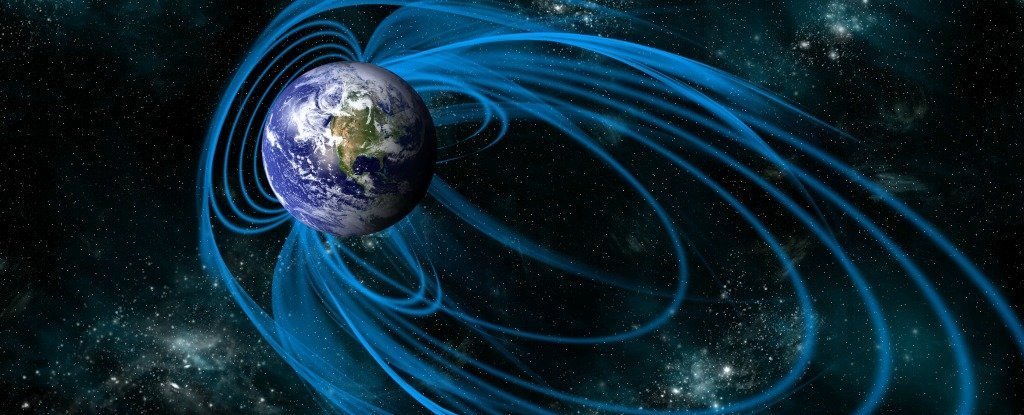Over the 400
years or so that humans have been measuring Earth's magnetic field, it has
drifted inexorably to the west. Now, a new hypothesis suggests that weird waves
in Earth's outer core may cause this drift. The slow waves, called Rossby
waves, arise in rotating fluids.
They're also
known as "planetary waves," and they're found in many large, rotating
bodies, including on Earth in the oceans and atmosphere and on Jupiter and the
sun. Earth's outer core is also a rotating fluid, meaning Rossby waves
circulate in the core, too. Whereas oceanic and atmospheric Rossby waves have
crests that move westward against Earth's eastward rotation, Rossby waves in
the core are "a bit like turning atmospheric Rossby waves inside
out," said O.P. Bardsley, a doctoral student at the University of
Cambridge in England, and the author of a new study on the Rossby wave
hypothesis. Their crests always move east.
Rotational
forces
The rotation
of magnetic iron in Earth's core gives rise to the planet's geomagnetic field.
The geomagnetic field, in turn, protects the planet from solar radiation,
making it important for life on Earth.
Without it,
the planet's surface would be bombarded by charged particles streaming from the
sun that would ultimately rip away Earth's atmosphere. While trying to
understand the waves that propagate throughout Earth's core, Bardsley realized
that some of these waves might explain one of the mysteries of the planet's
magnetic field. Over the past four centuries, scientists have made measurements
of magnetic declination — the difference between true north and the point where
a compass needle points. (Because the magnetic field is chock-full of little
local anomalies, the compass needle moves around a little compared to true
north depending on where you're standing.)
Throughout
those four centuries, the anomalies revealed by these declination measurements
have shown a tendency to move westward, Bardsley reported in the new research,
which was published today (May 15) in the journal Proceedings of the Royal
Society A.
“The westward drift manifests itself primarily as a series of blobs over the Atlantic near the equator,” Bardsley told Live Science, and they drift at around 10.5 miles (17 kilometers) per year.
East and
west
Theories to
explain the drift have typically focused on the dynamics of the outer core. The
most popular hypothesis, Bardsley said, is that the outer core contains a gyre
similar to the atmosphere's jet stream, which happens to be moving westward and
is dragging Earth's magnetic field along with it. The problem, Bardsley said,
is that there's no particular reason why this gyre should exist. It might very
well exist, he said, but given that there is no direct evidence, other
explanations are still possible. One possibility, Bardsley said, is that Rossby
waves explain the weirdness of the magnetic field on Earth's surface.
This is a
little odd, Bardsley said, because Rossby waves in the core have
eastward-moving crests, quite opposite the westward-moving drift. But crests of
waves don't always represent their total energy movement.
“It is
entirely possible to have a group of waves where the crests themselves are
going east but the [bulk of the] energy is going westward,” Bardsley said.
Something
similar can even happen with water waves. Their crests typically travel in the
same direction of the bulk of their energy, Bardsley said, but not necessarily
at the same speed. Surface measurements of the geomagnetic field capture the
bulk of energy movement, Bardsley said, but not all the wiggly little details.
So Rossby waves with a large-scale tendency to move energy westward could
explain the westward drift measured over the Atlantic Ocean.
The
small-scale details, like those eastward-moving crests, would be impossible to
detect. The westward drift and the Rossby wave hypothesis are largely unrelated
to a more famous question regarding the magnetic field: Is it going to flip?
Periodically throughout Earth's history, magnetic north and magnetic south have
swapped places. This isn't particularly problematic, except that it takes about
10,000 years, Bardsley said, and the process causes an uptick in anomalies and
a weakening of the magnetic field in between the poles.
A weakened
field can let more solar particles through, which can disrupt electric grids
and cause problems with navigational systems. However, scientists aren't
certain whether the weakening of the magnetic field over the past century or
two is a sign of an impending flip-flop or merely a recoverable wobble.






Post A Comment:
0 comments: